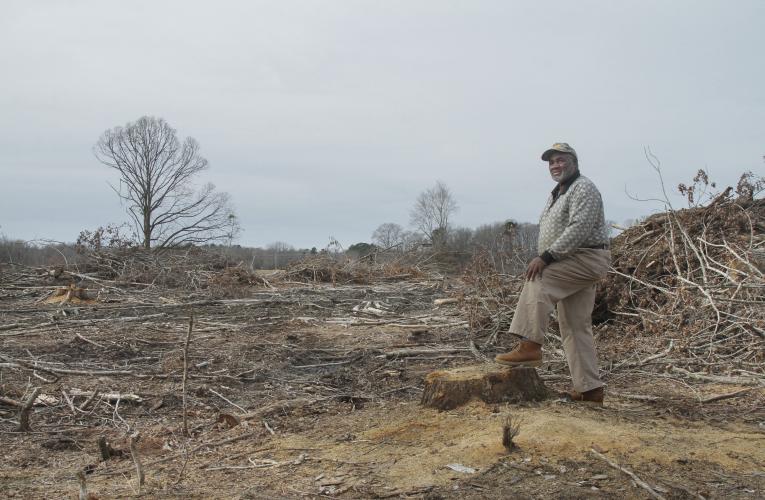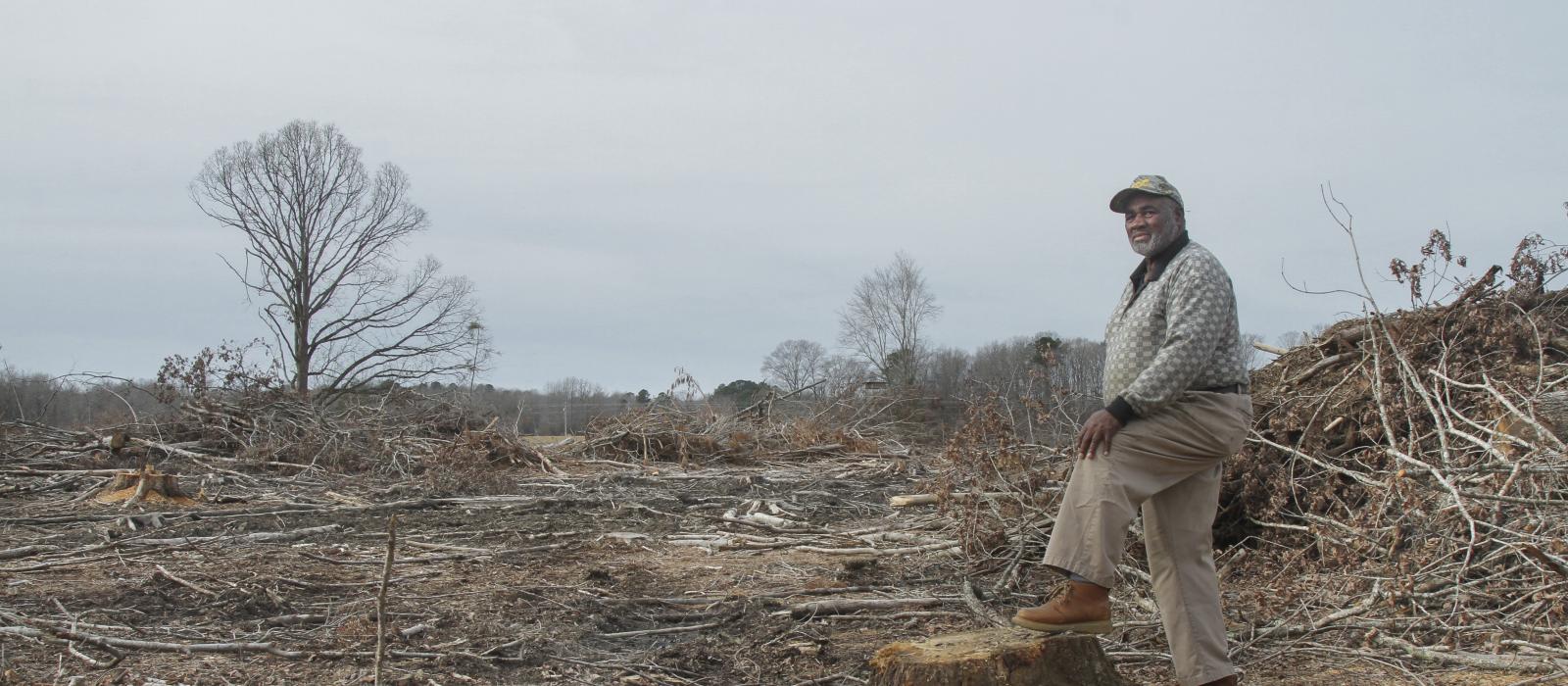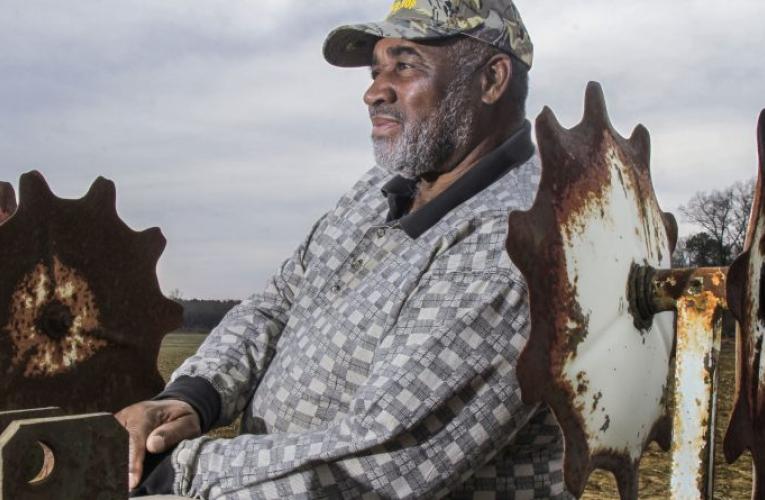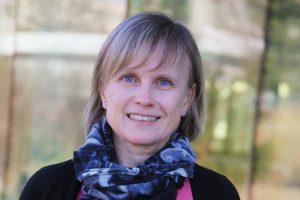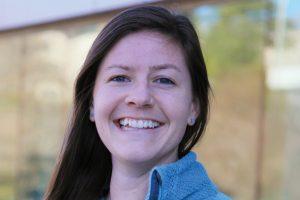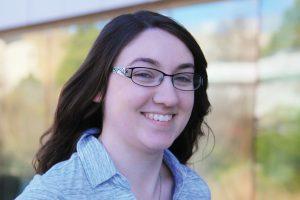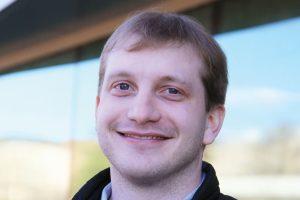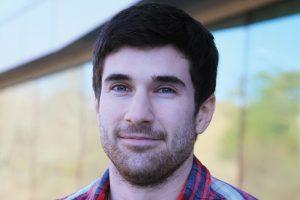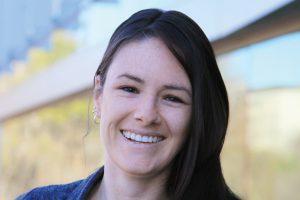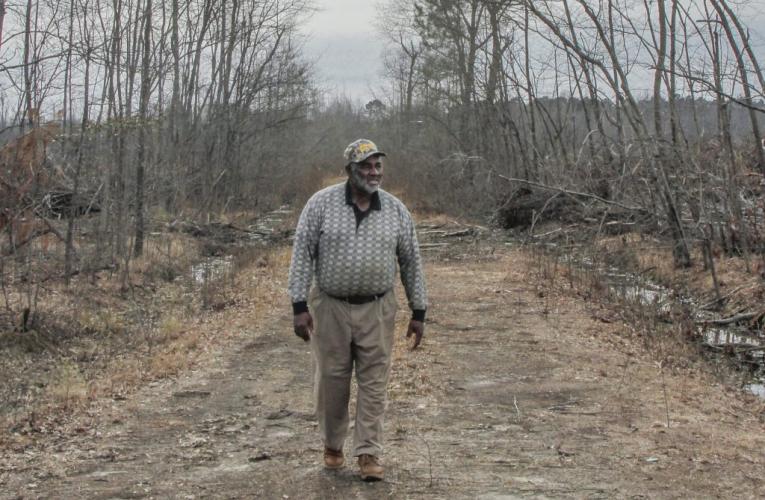Tim Lucas
(919) 613-8084
tdlucas@duke.edu
BY LILY HUFFMAN
James Peterson has been farming his land In Northampton County with the help of only one hired hand since 1984.
He’s weathered recessions and rising costs, fluctuating land values, an ever-changing regulatory landscape, droughts, hurricanes, blizzards and blights.
Through it all, the quiet-spoken former Marine has strived to manage his 77 acres of corn, wheat and soy and 75 acres of forests as smartly as possible to ensure that the land remains healthy and productive—and in family hands—for years to come.
But like many African American landowners in rural communities, he knows the odds are against him.
Peterson’s farm, which sits on gently sloping sandy loam about five miles outside the town of Rich Square in northeastern North Carolina, has been in his family since he was a child. It passed from one hand to another until he purchased it at auction in 1984.
“I worked on this farm as a boy,” he says. “My Granddaddy taught me how to work the land. And I want to pass it along to my children and grandchildren, too.”
In 1920, African Americans owned between 16 and 19 million acres of rural land and accounted for roughly 14 percent of the nation’s farmers. Today, they comprise less than 2 percent of farmers and less than 1 percent of rural landowners.
These numbers could shrink further in coming years as younger generations continue to leave the farm to pursue brighter prospects elsewhere and as stagnating rural economies, reduced access to government resources, and decades of systemic discrimination in agricultural lending practices take their toll on the farms
that remain.
Environmental Sciences & Policy Division
That’s where Sari Palmroth and five Master of Forestry (MF) and Master of Environmental Management (MEM) students at the Nicholas School of the Environment come in. The students are Kendall DeLyser, Alison Petro and Michelle Kaiser, all MEM/MF’18; Dan Hickey MF’18, and Tal Jacobs MEM’18. Last year they began collaborating with a regional nonprofit, the Sustainable Forestry and African American Land Retention Project (SFAALRP) to help Peterson ensure that his farm survives by showing him how to tap into a source of revenue he previously left untapped: His forests.
Palmroth, associate research professor, proposed the idea of working with SFAALRP and Peterson to her students as a way of incorporating real-world experience into the Silviculture Prescription course she teaches.
Under her guidance and with support from Tom Craven, the Duke Forest supervisor, they surveyed Peterson’s forest acreage, analyzed its economic and ecological value, and developed a management plan with multiple options for how he can generate sustainable revenues from it.
“I knew Kendall, Alison, Michelle, Dan and Tal would be up for the challenge, but the way they embraced it and ran with it—and the quality of the work they produced—far exceeded expectations,” she says.
Peterson already has implemented, and is benefitting from, one of the management options the students proposed.
Palmroth and Alton Perry, director of SFAALRP, are now making plans to have a second group of her students work with another farmer next year.
“Northampton County is only a two-hour drive from Raleigh-Durham, but in a lot of ways it’s a world apart. Landowners here don’t have the same access to resources and information,” says Perry, a forester by training who has led SFAALRP since its launch in 2013. “Being able to tap into the expertise of Nicholas School students has made a huge difference.”
SEEDS OF CHANGE
SFAALRP currently works with about 170 farmers in seven economically distressed northeastern North Carolina counties served by the Roanoke Electric Cooperative. Its mission is to educate them about forest management practices; connect them to the resources, technical assistance and information they need to best utilize their land; and work with them to develop an individualized management plan they can follow.
“Landowners whose primary income comes from farming sometimes don’t realize the benefits their forests could provide. They think of them as more of a liability. We’re trying to change this way of thinking by showing them how productive these lands can be,” Perry says.
When he talks to a local farmer who’s not yet taking part in the program, he likes to point out that in 2012, small-landowners in the seven-county area earned about $37 million in timber sales.
“A number like that really catches their attention,” he says. “And then I point out that it represents only a small portion of the potential forest income local landowners could be bringing in through planned management.”
Reaching out to absentee owners also is a priority, Perry says. As ownership of small family farms passes from generation to generation, it’s becoming increasingly common that the children, grandchildren, nieces and nephews who inherit these lands no longer live on them.
Many have moved far away and—if they think of the family land at all—view it as a burden they’d like to unload rather than as a sustainable source of long-term income from timber production, hunting rights, conservation credits or other revenue streams.
“Keeping these lands productive and in family hands benefits the families, the environment and the local economy,” Perry says. “Our challenge is to show these owners how valuable their land can be and to provide them access to the local resources and expertise they need to manage it.”
To participate in SFAALRP, landowners must own at least eight contiguous acres of land, although most own between 50 and 60 acres, on average. Despite the programs’ name, it serves landowners of any racial background who meet the minimum-acreage requirement.
Providing individualized land management plans and ongoing assistance to each SFAALRP member sometimes stretches the organization’s grass-roots resources to their limits, according to Perry.
And demand is only going to rise in coming years as more landowners learn about the program and seek its help in generating forest revenues that will help them hold on to their family-owned lands.
“Being able to rely on Sari and her Nicholas School students to do Mr. Peterson’s management plan was a big help,” he says. “They brought some great ideas to the table and gave Mr. Peterson a plan that meets his needs today but can also be a blueprint for managing his forests for years to come.”
A PLAN TAKES ROOT
The biggest challenges Palmroth and her students faced in developing their management plan for Peterson were the same things that drew them to him as a client in the first place: The size and complexity of his land.
Rather than being a contiguous stand of trees, Peterson’s forested lands are spread out in parts and parcels of various shapes and sizes across his property. Some are in wetland soils, others are in well-drained loam. The ages and sizes of the trees, and the proportion of hardwoods to pines, vary from tract to tract, as do their ecological and economic values.
Palmroth provided general guidance, but left it up to the students to decide how to tackle the project and present their final recommendations by the end of the month-and-a-half-long course.
They divided the work assignments based on personal skills and the time each student could commit for doing fieldwork in Northampton County. So Hickey and Kaiser took the lead on gathering field data, while DeLyser, Petro and Jacobs were charged with handling much of the analysis and modeling back in Durham.
“Although none of us had ever done such an extensive client-based land-management plan before, we had learned the skills and tools we needed in previous forest management and silviculture courses that led up to the project assignment, so we were pretty confident,” says Hickey.
To ensure that their recommendations would meet Peterson’s short-term and long-term financial objectives, they divided his forests into seven different tracts based on land composition. Each tract was then evaluated using three different management scenarios—no management at all; meeting landowner objectives; and achieving maximum timber values—to determine which approach made the most sense.
After reviewing all the options, the students developed a management plan they felt balanced economic and ecological considerations, while still being feasible for Peterson to carry out.
“When we first met Mr. Peterson, he told us he wanted to know what he could do to set his land up so he didn’t have to work it anymore but so that each of his kids, and then each of his grandkids, would eventually see some benefits from it,” says DeLyser. “With this in mind, we ended up suggesting a small-scale clear cut of some hardwoods on the property, which wasn’t our top choice from an ecological point of view but was better than many of the alternatives.”
“We really wanted to suggest doing a shelterwood cut, which involves leaving some trees standing instead of clear-cutting,” Petro explains. “But it’s a bit more difficult to do, and you really need to have a good contractor or logger out there to make sure you’re taking out the right trees. Even then, you might not get the same species coming back. Given Mr. Peterson’s objectives and the need to make our plan feasible under real-world constraints, a small-scale clear cut was the best compromise.”
GROWTH AND BALANCE
Some of the sting of recommending the clear cut was eased by the knowledge that other stands on the property may never be logged.
“Part of Mr. Peterson’s land is a wetland forest with high conservation value. We informed him that although it could be logged, it would be a wreck afterward so it made more sense to look into conservation easement programs as a source of income instead,” says Kaiser.
Learning to make tough decisions and put the client’s objectives first is all part of the lesson plan, Palmroth says.
“Learning these skills and concepts in the academically rigorous environment of a classroom is challenging. Applying them outside the classroom, on a tight deadline, for a real person who is relying on you for the best guidance possible because his future depends on it, is another challenge entirely,” she says. “I have rarely seen students as motivated by this responsibility as this group was.”
Petro says that getting to know Peterson and understanding the positive impact their work could have for him and his family made all the late nights and hard compromises worthwhile. “Working with a landowner like Mr. Peterson, who was
so supportive and receptive to our recommendations, really inspired us,” she says.
The admiration is mutual.
“These students did a marvelous job on my forestry plan. They gave me a lot to work on and work with, and advised me on things I didn’t know about in the beginning,” Peterson says. “And they worked so hard—the first day they were here, they were out in the woods collecting samples for so long I worried they had gotten lost.”
Perry, too, is impressed—not only by the quality of the students’ work, but also by the potential for continued collaborations.
“For programs like the SFAALRP, increasing our operational capacity can be a challenge. Demand always outstrips supply. By having students work with some of the landowners we partner with, I think there’s an opportunity to expand the services we offer to countries beyond our current project area and help even more small-landowners,” he says. “I can’t say for sure this will happen, but it’s an idea I hope can be entertained in the very near future.”
Peterson—who has already made his first cut based on the students’ recommendations and is discussing plans with Perry to treat the cleared land and replant it in winter 2019—says he’ll be more than happy to serve as an enthusiastic reference if other landowners wonder what it’s like to work with Nicholas School students.
“I’d tell them: I trusted those students to make the right decisions for me and provide me with the knowledge I need to manage my land,” he says, “and they didn’t let me down.”
Lily Huffman MEM’19 is the Nicholas School’s Student Communications Assistant
